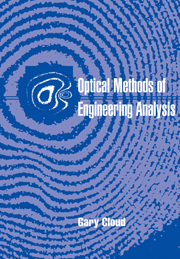Book contents
- Frontmatter
- Contents
- Acknowledgments
- 1 Introduction and orientation
- Part I Optics and interferometry
- Part II Photoelasticity
- Part III Geometrical moire
- Part IV Diffraction theory, optical processing, and moire
- Part V Moire interferometry
- 13 Principles of moire interferometry
- 14 A moire interferometer
- 15 Experimental methods in moire interferometry
- Part VI Holographic interferometry
- Part VII Speckle methods
- Author index
- Subject index
15 - Experimental methods in moire interferometry
Published online by Cambridge University Press: 12 January 2010
- Frontmatter
- Contents
- Acknowledgments
- 1 Introduction and orientation
- Part I Optics and interferometry
- Part II Photoelasticity
- Part III Geometrical moire
- Part IV Diffraction theory, optical processing, and moire
- Part V Moire interferometry
- 13 Principles of moire interferometry
- 14 A moire interferometer
- 15 Experimental methods in moire interferometry
- Part VI Holographic interferometry
- Part VII Speckle methods
- Author index
- Subject index
Summary
Described here are details of procedures for analysis of displacement and strain in deformable bodies using moire interferometry. Some of these techniques have parallels in other optical methods, but the rest are specific to moire interferometry. The chapter closes with some sample results from various applications of the method.
Specimen gratings
Utilization of the moire effect in experimental measurements depends on the successful forming of line grids (or dots) on the surface of the specimen. The spatial frequencies of the gratings employed in moire interferometry fall in the range of a few hundred to several thousand lines/millimeter (roughly 5,000 to 50,000 lines/in.). If we recollect from the discussion of Fourier optics that the spatial frequency bandpass of a quality lens is limited to about 200 lines/mm, then we understand that no method of optical imaging is adequate for replicating gratings for moire interferometry, even supposing that a master grating is available to begin with.
The problem has three aspects. In the first place, some sort of master grating at the desired frequency must be created. Then, gratings suitable for transfer to the specimen must be manufactured. Finally, the gratings must, indeed, be somehow fastened to the specimen. Only after solving these problems can moire interferometry be undertaken. Walker (1994) outlines the several approaches that have been pursued through recent years. Post, Han, and Ifju (1994) also describe various techniques.
Of course, very fine and precise diffraction gratings have long been made by mechanical means. Such gratings tend to be very expensive and to exist only in small sizes.
- Type
- Chapter
- Information
- Optical Methods of Engineering Analysis , pp. 323 - 340Publisher: Cambridge University PressPrint publication year: 1995

